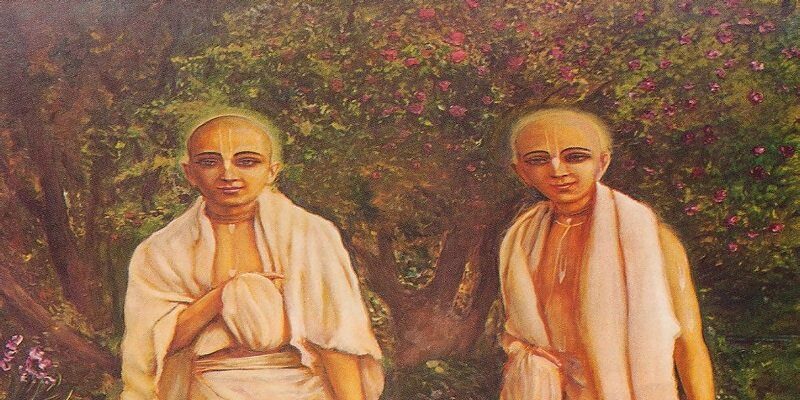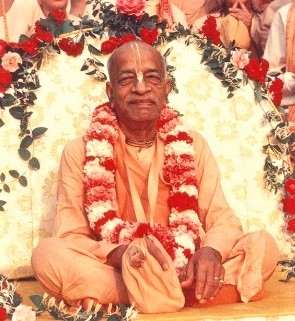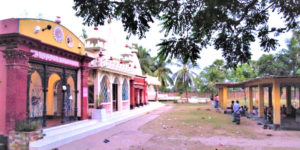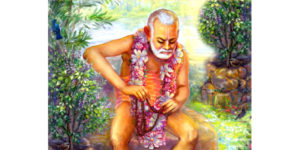Srila Bhaktisiddhanta Saraswati Thakur has written in his Anubhasya of Caitanya-caritämåta about the offspring of Srila Rupa Goswami and Srila Sanatana Goswami, “There was a great scholar named Sarvajïa who was a world-renowned spiritual master from Bharadvaja Gotra, who appeared in 12th century in the Brahmin-dynasty of Karnataka state. His son Aniruddha had two sons named Rupeçvara and Harihara. But when they both were deprived of the kingdom, the elder brother, Rupeçvara, started living in a place named Shikhar Bhümi. The son of Rupeçvara was Padmanava, who had five sons and lived in a place named Naihati, near the bank of Ganges. The youngest son was Mukunda, who himself had a great righteous son named Kumardeva, who lived in Bakla Candradvépa (Barishal). He is the father of Rüpa, Sanätana, and Anupama.” Sri Bhakti-ratnäkara (1/564-565) states, “Being displeased by the relatives, they left the Nabahatta village at that time and immediately went to Bengal and started living in the Bakla Chandradwip village.”
Srila Sanatana Goswami appeared in 1493 AD and Srila Rupa Goswami appeared in 1488 in the Bakla Chandradwip. Sometime after the birth of Anupama, their father Kumardeva passed away and during this time their grandfather told them to go Rämakeli for acquiring knowledge. Srila Bhaktisiddhanta Saraswati Thakur has described Rämakeli as the birthplace of Çréla Jéva Gosvämé in his Anubhasya of Caitanya-caritämåta.
From childhood, the three brothers were great scholars in all scriptures. Never spending time in childish games, they were fully absorbed in the nectar of Çrémad-Bhägavatam. By this time, their glories were spreading all over the world, and the former emperor of Bengal, Hussien Shah, proposed that they accept the ministerial management of his kingdom.
They were compelled to accept this ministerial power due to fear of the Muslim emperor. Hussien Shah appointed Sri Sanatana as prime minister, Sri Rupa as Finance Minister, and Çré Ballabha as the president of the revenue department. Because of their combined intelligence, the Bengal kingdom expanded day by day. At that time, if someone was employed under the Muslim Nawab, they would have been abandoned by the society. The nickname of Sri Sanatana was ‘Amar,’ and Hussien Shah named him Shakara Mollick, while Rupa Goswami was known as Dabir Khas and Anupama was named Anupama Mollick.
At the same time, Mahaprabhu was performing his deliverance pastimes of fallen souls. The great sinners Jagäi and Mädhäi also became great Vaiñëavas by His mercy. Mahaprabhu delivered Subuddhi Khan, who was outcaste by Hussein Shah, by giving him the holy names and sending him to Våndävana. Knowing about the deliverance of Subuddhi Khan, Sanätana, Rüpa, and Anupama heavily desired Mahaprabhu’s mercy. With determined hearts, they wrote to Mahäprabhu and begged for His mercy. Then Mahäprabhu wrote an allegoric çloka to console them: “The woman who is addicted to adultery, though she is engaged in household work, is always thinking about the companionship of the new boyfriend in her mind.” Keeping their deep faith for Kåñëa in their hearts, Mahäprabhu told them to perform their royal responsibilities externally.
They planted tamala and kadamba trees and created Rädhä-kunòa, Çyäma-kunòa, Mädhaviläta-kuëòa, and tulasé gardens in Rämakeli just as in Våndävana, and continued to worship Çré Madan-mohan. When they heard that Mahäprabhu had taken sannyäsa and left for Puré-dhäma, they were very sad and lamented His leaving. Then there was a prophecy revealed to them, “Don’t be upset, immediately Gaurahari will appear before you.” At that time, Mahäprabhu had visited the northern lands and came to Bengal with the desire to see his own mother and the Gaìgä River. He also went to Våndävana, but rather than going directly from Bengal, He went to Rämakeli village to deliver Rüpa and Sanätana. Learning of Mahäprabhu’s auspicious arrival, the devotees from the surrounding areas came to visit Him.
Observing that millions and millions of people were crowded around this sannyäsé, Hussein Shah became worried and wanted to know the reason from Sanätana, who told him, “Why are you asking me: ask yourself! The Lord has given you a kingdom due to your good fortune, and now he has come to your country. No one but the Supreme Lord has such power or attraction.” That evening, Mahäprabhu was sitting on the banks of the Ganges, surrounded by some of His associates. Taking blades of grass in their teeth, Rüpa and Sanätana very humbly came before Mahäprabhu and paid obeisance to His lotus feet. Mahäprabhu hugged them tightly and said, “You are very dear to Me, life after life.”
The youngest brother of Rüpa and Sanätana, Çré Anupama, also took darçana of Mahäprabhu, along with other family members. Mahäprabhu showered his special mercy on the child Çré Jéva by touching Jéva’s head with His lotus feet. When Mahäprabhu left that place, Rüpa and Sanätana resigned from royal responsibility and sent their other family members to Candradvépa and Fatehabad. Çré Rüpa and Anupama reserved some wealth in Rämakeli for Çré Sanätana, and then came to Fatehabad (Premabagh in Jessore) by boat with everything they had. They distributed half their wealth among the Vaiñëavas, Brahmins, and their relatives, and saved the other half for any necessity in the future. Çré Jéva was raised in Bakla. He was deeply absorbed in saìkértana, and had darçana of Çré Mahäprabhu. After that, he left for Navadvépa.
Rüpa and Sanätana went to Prayäga to meet with Mahäprabhu. They paid their humble obeisances to Mahäprabhu from a distance. Mahäprabhu took Çré Rüpa to Dasasvämedha-ghat and taught him about Kåñëa consciousness.
prabhu kahe, — śuna, rūpa, bhakti-rasera lakṣaṇa
sūtra-rūpe kahi, vistāra nā yāya varṇana
pārāpāra-śūnya gabhīra bhakti-rasa-sindhu
tomāya cākhāite tāra kahi eka ‘bindu’
“Śrī Caitanya Mahāprabhu said, ‘My dear Rūpa, please listen to Me. It is not possible to describe devotional service completely; therefore I am just trying to give you a synopsis of the symptoms of devotional service. The ocean of the transcendental mellows of devotional service is so big that no one can estimate its length and breadth. However, just to help you taste it, I am describing but one drop.’ (Cc. Madhya-lélä 19.136-137)
Saying this, Çré Caitanya Mahäprabhu hugged Çréla Rüpa Gosvämé. Then Mahäprabhu decided to go to Väräëasé. According to Mahäprabhu’s instruction, Rüpa and Anupama went to Mathurä and met with Subuddhi Roy at Çré Dhruva-ghat. By this time, Sanätana was freed from prison by bribing the guard, and met Mahäprabhu at Kashi. Two months later, Sanätana took the high road to Mathurä through. When Çré Rüpa and Anupama came to Kashi. they became very happy to hear the news about Sanätana from Tapan Miçra. Soon after they arrived in Bengal, Anupama died. Then Çré Rüpa left home forever to meet with Mahäprabhu, staying in Nélacala at Haridäsa Öhäkura’s bhajan-kuthir.
After seeing Mahäprabhu, Çré Rüpa paid his humble obeisance unto Him. One day he told all the associates, “You all please bless him with the special potency to write devotional literatures.” Rüpa Gosvämé wrote the famous Lalitä Mädhava and Vidagdha Mädhava while there. Staying until Dolayatra, he went to Våndävana after bidding farewell to the devotees.
According to the instructions of Çré Caitanya Mahäprabhu, Sanätana went to Våndävana from Kashi, visiting different lélä-sthalé on the way. By these visits and by touching the earth of Çrédhäma Våndävana, Çré Sanätana Gosvämé was very pleased. But when he felt deep separation from Mahäprabhu, he went to Nélacala and stayed at the home of Haridäsa Öhäkura. There he had the darçana and association of Çré Caitanya Mahäprabhu, and after some time again went to Våndävana according to Mahäprabhu’s instructions.
Mahäprabhu had performed some special activities with the two brothers, most especially establishing pure devotion in this world, discovering lost térthas Vraja-maëòala, and revealing and preaching Vaiñëava småti. Çré Rüpa Gosvämé prayed for the manifestation of Çré Govindadeva and Çrématé Våndä-devé, while Sanätana Gosvämé found Çré Madan-mohan and built a nice temple for His worship. After that, Jéva Gosvämé also came to Våndävana on Nityänanda Prabhu’s instruction to study scripture and worship Çré Çré Rädhä-Dämodara with Rüpa Gosvämé. Then he taught Çréniväsa, Çyämänanda, and Narottama, and handed to them the responsibility to preach the “Gosvämé books.”
All three had written many books. Among them, Bhakti-rasämåta-sindhu, Ujjvala-nélamaëi, Laghu- bhägavatämåta, Danakeli-kaumadi, Båhad-bhägavatämåta, Çré Hari-bhakti-viläsa, Çré Kåñëa-lélä-stava, Ñaö-sandarbha, Laghu–Vaiñëava-toñaëé, Ñaö-sandarbha, Saìkalpa-kalpadruma, Hari-nämämåta-vyäkaraëa. In 1558 AD, Sanätana Gosvämé departed this world, followed by Çré Rüpa Gosvämé in 1564.
Bakla Candradvépa, the birthplace of Vaiñëava Äcärya Çréla Sanätana Goswami, Çréla Rüpa Gosvämé, and Çréla Anupama, is now situated in Barishal district, Bangladesh. Candraçekhara Äcärya also lived on this island. But no memorial of Rüpa-Sanätana, or their family, can be found there. A traditional building of an old palace is all that remains, along with a traditional old temple. King Dilip Kumar had lived there with his wife and sons.
How to Go There
From the bus stand of Barishal city, first take a bus on the Banaripara-Svarupakathi route, and after getting down at Mädhavapasha Bazaar, walk 5 minutes to Bakla Candradvépa.
You can see other Holy Places. Click Here






